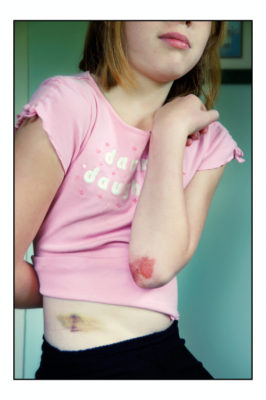THE TRUE FACTS ABOUT COMMON CHILD DAYCARE INJURIES

Childcare settings are all about educating children through games and activities. But when something goes wrong, you might begin to question every detail of what goes on at your child’s daycare. To gain a better understanding, let’s start with our own game of “True or False.”
- Licensed childcare facilities have a legal responsibility to prevent and report any and all child injuries that occur. This is, of course, true.
- Childcare professionals should be trained on how to respond to any and all injuries that might occur to children under their care. Again, this statement is true.
- If your child is injured while at daycare, it is a result of abuse and should be treated and documented as such. False!
In fact, the most common injuries that occur in a daycare setting are unintentional and not a result of abuse at all. You can’t always keep your children happy, but when you drop them off at daycare, you at least want to know that they’ll be safe. Yet while childcare providers ought to be attentive and experienced enough to prevent injuries, sometimes accidents still happen.
As a parent or guardian, you’re bound to worry about your kids and what could happen to them. Worrying is normal, but an excessive amount of anxiety can be unhealthy for you and your children. One important thing to know is that while sometimes a child’s injury at daycare can be severe, it doesn’t necessarily indicate abuse.
Unintentional Daycare Injuries
Hopefully if a child gets injured while at daycare, it was an accident. That being said, even accidents can result in serious consequences. Here are the most common unintentional injuries that children face in a daycare setting:
- Minor injuries, such as cuts, scrapes and bruises
- Severe injuries, such as dislocations, broken bones, head or neck injuries, internal injuries and dental injuries
- Unintentional poisoning
- Drowning or near-drowning
- Burns
- Choking or suffocation
As you may have noticed, some of these injuries are much more severe than others. Parents of very young children, however, have less reason to worry. Reports indicate that the rates of injury are low for infants, and actually increase with the age of the child. Children between the ages of two and five are more susceptible to getting inured at daycare. Meanwhile, at age five, the rate of injuries is higher for boys because they tend to be involved in more active physical play than five-year-old girls.
How and Where Does It Happen?
Falling is the leading cause of child injuries at daycare. Not surprisingly, 50 to 60 percent of childcare injuries take place on the playground, where kids tend to fall down left and right as they climb over each other to get to the slide and struggle to make it across the monkey bars. Sometimes other objects, such as furniture or toys, are involved in children getting injured at daycare. One kid fighting another over a toy might trip over whatever’s lying on the ground and bang their head on the way down. It is the responsibility of the childcare supervisor to step in before that happens, but sometimes these things happen so fast that he or she can’t get there in time.
Other injuries that definitely indicate oversight or carelessness, but can still be considered unintentional, are when a child gets cut by a sharp edge, burned by a hot surface or hot water or poisoned by toxic materials. It’s also worth noting that sometimes children get injured in a car or bus while being transported to a field trip location.
Intentional Injuries
When it comes to a daycare setting, intentional injuries are less common. They are generally a result of an overly aggressive child or, worst-case scenario, a caretaker committing acts of child abuse. Some children engage in aggressive behavior because of behavioral problems that can either be genetic or a result of their home environment. For instance, it’s not uncommon for a child with parents going through a divorce to become aggressive in a daycare setting. Parents and childcare supervisors can help these children out by remaining sensitive to their emotional needs, reinforcing coping skills and encouraging them to take part in other physical activities that release anger, such as kicking a ball or running.
If your child comes home with unexplained or repeated injuries, or injuries that don’t make sense such as bruises in the shape of an object or broken bones in a child that can’t walk or climb, this might indicate abuse. If you have any suspicions that your child is being abused at daycare, don’t hesitate to contact your local police department as soon as possible.
*Image courtesy of Jesse Millan
